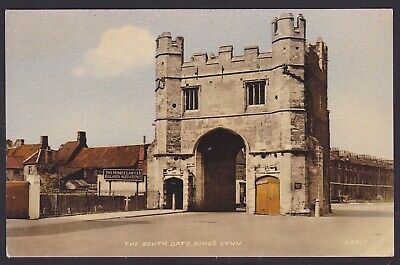The South Gate: The Need For A Big Statement
At the beginning of the C15th Bishop’s Lynn (what was to become King’s Lynn in 1537) was a prosperous and proud town. After starting life just over three hundred years earlier it had grown into a large medieval port whose wealth at the time was only beaten by London and Southampton. The town’s position on the east coast enabled it to benefit from the trade with the continent. The River Great Ouse gave the port a large hinterland for distributing and collecting goods (10 counties), so the import and export trade flourished.
The defences of the town had first been constructed in the C13th. Initially the gates to the town would have been guarded by wooden towers. The earliest known structure guarding the road into Lynn from the south was a wooden tower or ‘bretask’ built at the time of King John’s quarrel with his barons in 1215. The first south gate built of stone probably appeared during the reign of Edward III (1312-1377). The southern tower was certainly in place by 1325. It was repaired in 1359, and the whole structure was replaced by 1377 with a stone built structure. The gate was repaired in 1416 using waste stone from the repair of St Nicholas’ Chapel, and it either fell down or was demolished 20 years later.
In 1437 the Mayor and burgesses of the town, like many councillors before and after, decided that the town needed to look more impressive to reflect its wealth and status. However, the south gate was in dire need of repair. It was an opportunity to rebuild the structure to give a powerful non-verbal message to visitors.
Robert Hertanger, a builder from London (originally from Kent), who had previously worked on London Bridge, got the job. He had plenty of ideas that resonated with what the councillors were thinking. He suggested using bricks as well as stone. He also offered a 20 foot high arch with a rib vaulted ceiling, a grand room for welcoming important guests, and an extra chamber for gate staff (including an inside toilet chute).
The South Gate: The Money Disappeared
Hertanger was given a substantial advance payment. The money was there initially, as were the ideas, and the rebuilding started using some of the foundations of the former structure. But somehow the determination to complete the job got dissipated. Hertanger went bankrupt and lost the contract in 1439. The South Gate was eventually topped off with a temporary roof and although the gate worked, the town was left with an unfinished building.
The South Gate: It Was Finished

Sometimes a visit by an important person can shame people into action. The completion work had been under consideration for some time. In 1494 four persons were charged with going round the town and determining “men’s minds and good wills what they will give to the making of the South Gate”.
However, it took a visit by Cardinal Wolsey in August 1520 (and the presumed embarrassment) to get things moving again. After his visit Mayor Thomas Myller commissioned two local masons (Nicholas and Thomas Harmer) on 5 October 1520 “to make up the South Gates as good and cheap as they can get them…” The new builders abandoned the rib vaulting in favour of cheaper barrel vaulting.
The South Gate: It Survived
At the advent of the Civil War (1642), the mayor ordered that the bridge to the south of the gate be converted to a drawbridge. However, there is no evidence that these works were undertaken. The size of the portcullis arch suggests that it is unlikely that there ever was a functioning portcullis. As Francis Pyror notes, “the gate was constructed as much to impress as to defend”.
However, this is disputed, and others argue the front archway has slots in which a portcullis would have been raised and lowered, and immediately behind these are rebates for the two great wooden doors. The floor of the chamber over the central vault was strong enough to carry the winch mechanism to raise and lower the portcullis. There were also 6 round ports for handguns.
The gate was occupied by a gatekeeper from at least 1602. However, the post of gatekeeper was finally abolished in 1741, 20 years after tolls for entering and exiting had been abolished.
Between 1800 and 1804 London Road was built providing a wider, easier route from the gate to the centre of King’s Lynn. Pedestrian passage ways were constructed in the gate in 1817 (east) and 1841 (west).
The Grade I listed building is currently owned and maintained by the Borough Council of King’s Lynn and West Norfolk.
Footnote The South Gate is often referred to locally as The South Gates.
For an account of an unfortunate event at the South Gate, see The Princess, The Folly, and The Train.
© James Rye 2023
Book a Walk with a Trained and Qualified King’s Lynn Guide
Sources
- Borough Council of King’s Lynn & West Norfolk The South Gate Leaflet
- Historic England https://historicengland.org.uk/listing/the-list/list-entry/1195304
- James, E.A. (1987), ‘Fresh Study of the South Gate at King’s Lynn, in the Light of Recent Restoration Work’, Norfolk Archaeology, Vol. XL, 55-72
- Pryor, F. (2007) Britain in the Middle Ages: An Archeological History, Harper Perennial
- Society for the Protection of Ancient Buildings https://www.spab.org.uk/news/national-treasure-south-gate-king’s-lynn-norfolk

[…] visit but the town’s dignitaries got wind of it and waited for the royal party’s arrival at the South Gate. Excited crowds gathered, and in an age with limited technology, people were anxious to actually […]